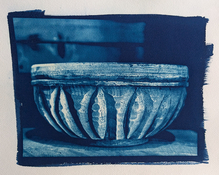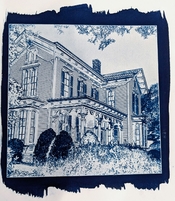Way back in June, Niranjan (
@nmp) posted a cyanotype toned with sumac, see:
https://www.photrio.com/forum/threads/showcase-for-your-hcwps.199853/page-20#post-2803705
Seeing this very nice print piqued my interest in toning cyanotypes, a topic I had explored several years ago, see:
https://www.photrio.com/forum/threads/on-the-toning-of-cyanotypes.175185/
Thus, I bought
Annette Golaz's book about toning cyanotypes with botanical material, see:
https://www.routledge.com/Cyanotype...ueprints-Naturally/Golaz/p/book/9780367553548 and, earlier this week, I did some tests following the method she describes. I'll not describe the method. Buy the book if you are interested; authors deserve to be compensated for their efforts.
The last time I made cyanotypes was four years ago. All of these prints were made on Hahn. Bamboo Mixed Media paper using traditional cyanotype chemistry with one small change; the stock solutions which were mixed 1:1 by volume were both 10% (w/v) rather than the more typical 25% and 10%. Prints were 'developed' in 15% vinegar and then washed extensively. Toning occurred several days after printing... i.e. the prints were dry before they went into the toning tray.
I was half expecting results similar to those seen with the typical tea, etc. toning of cyanotypes (lots of staining of the paper with concomitant loss of contrast) but was very pleasantly surprised with the results.
Here are a few of my results:
Cyanotype toned with ferns (foraged from my yard)
Cyanotype toned with sumac gall tannins (purchased from a supplier of natural dyes)
Cyanotype toned with marigold (purchased from a supplier of natural dyes)
Cyanotype toned with weld (purchased from a supplier of natural dyes)
Untoned Cyanotype
And one more... sorry for the different negative. I ran out of prints of the other image.
Cyanotype toned with dried tarragon (from the grocery store)
The supplier of natural dyes I bought from is
https://longridgefarm.com/. They are located fairly near my home which is why I chose them. I took a drive and picked up small amounts of various materials rather than having them shipped.















